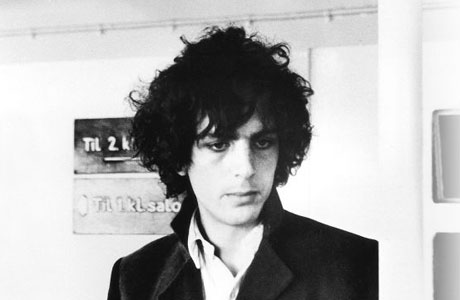Syd Barrett - Pink Floyd
Syd Barrett, originally known as Roger Barrett, was born in a middle-class family in Cambridge on January 1946. Being an acknowledged English singer, song writer, artist as well as a guitarist, Syd was a versatile musician, who performed several acts at the same time. Syd has been able to make an enduring place in the hearts of music lovers for his role as the founder member of the British rock group Pink Floyd, which is said to be a subculture of psychedelic drugs.
Early Days
Since his young days, both his father Max Barrett, a well-known pathologist of the area, and his mother Winifred encouraged Roger in his musical endeavors. At a tender age of 14, his remarkable performance as a musician earned Roger the nickname ‘Sid’ or ‘Sid Barrett’ that referred to a previous popular jazz drummer from the Cambridge locality. Roger, however, changed the spelling of his name to Syd Barrett to maintain his individual identity.

During the Pink Floyd’s formative days, Syd was responsible for making available the entire key melodic as well as stylistic trend and brilliance to the group’s initial compositions. Syd remained with Pink Floyd only for a brief period from 1964 to 1968 and suddenly quit the group giving rise to gossips that he was weary of mental illness owing to his addiction to drugs.
Pink Floyd Days
During Syd Barrett’s association with Pink Floyd, the group experienced numerous name changes that included ‘The Abdabs’, ‘The Screaming Abdabs’, ‘Sigma 6’ and even ‘The Meggadeaths’. Syd joined the group when it was called ‘The Tea Set’, but was soon dismayed to find that there was another rock group by that name. This made Syd Barrett come up with a new name ‘The Pink Floyd Sound’ and later changed it to ‘Pink Floyd’ by combining the first names of Pink Anderson and Floyd Council – two prominent blues singers.
During the initial days, the Pink Floyd, much like its contemporary The Rolling Stones, The Kinks and ‘The Yardbirds’, played the title adaptations of American R&B songs, but by 1966 it developed its exclusive style blending improvised jazz with British pop-rock. Soon Pink Floyd became a popular name and occupied much of the performances at the UFO; a new rock concert venue in London that developed into a sanctuary for the British psychedelic music. Adding to its gains, by the end of 1966, Pink Floyd obtained the valuable services of two dependable managers – Peter Jenner and Andrew King.
Health
Syd Barrett suffered from various psychological problems. One was schizophrenia. Also, a manic depression or bipolar disorder was diagnosed.
His psychological illness was due to his use of psychedelic drugs, most notably the LSD. Gilmour stated in an article that, “In my opinion, his breakdown would have happened anyway. It was a deep-rooted thing.” Gilmour also added, “But I'll say the psychedelic experience might well have acted as a catalyst. Still, I just don't think he could deal with the vision of success and all the things that went with it."

Last Days
Unfortunately, Syd Barrett’s life as an active rock musician was very brief and lasted for barely seven years. During his association with Pink Floyd, Barrett recorded two group and solo albums. Though it is believed that his life as an active musician was cut short owing to his addiction to drugs, even after Syd Barrett withdrew from public life, there have been numerous appreciations, especially his former band Pink Floyd’s tribute to him in its 1975 album ‘Wish You Were Here’. Syd Barrett’s self-imposed seclusion lasted for over 30 years and came to an end with his death in 2006.
Susanna Hoffs - The Bangles
Born in a Jewish family as Susanna Lee Hoffs on January 17, 1959 in Newport Beach in California, Susanna Hoffs is an American vocalist, guitarist and actress who is best recognized as a member of the all-female pop group called ‘The Bangles’.
Early Years
Susanna’s mother Tamar Simon Hoffs was an ardent fan of The Beatles and often played their records for her when she was a child. When Susanna was in her teens, she took up playing the guitar and associated with Vicki and Debbi Peterson who were looking for a singer for their band that would later develop into ‘The Bangles’. In the meantime, Susanna attended the Palisades High School in Pacific Palisades, Los Angles. And in 1980, she graduated from the University of California, Berkeley, with a B.A. in Art.
Career With The Bangles
After her graduation, Susanna joined the all-female band called ‘The Bangles’, which released its debut album ‘All Over the Place’ in 1984. While this album was a modest hit owing to the single ‘Hero Takes a Fall’, the group tasted its first commercial success with the release of its second album ‘Different Light’ in 1986. This album contained two super hit singles – ‘Walk Like an Egyptian’ and ‘Monday Maniac’. In the same year, Susanna Hoffs co-wrote the song ‘I Need a Disguise’ for Belinda Carlisle’s debut album titled ‘Belinda’.

In 1987, Susanna Hoffs acted in the movie directed by her mother Tamar Simon Hoffs ‘The Allnighter’ and gained some fame as an actress. As Susanna Hoffs became more and more famous, she began to appear on the covers of several magazines and the Rickenbacker Guitar Company released a Susanna Hoffs model, which the artist modified and still continues to play in her live concerts. Interestingly enough, though ‘The Bangles’ did not have any lead singer and each vocalist sang leads on different subjects, many of Susanna Hoff’s ardent fans regarded her as the lead vocalist of the band.
In 1988, The Bangles released their third album titled ‘Everything’ and this contained their best selling single ‘Eternal Flame’ Despite such success, The Bangles split up in 1989 However, Susanna did not give up hope and in a bid to reunite the members, she contacted each of them and in 1999 they recorded a single ‘Get the Girl’ for an Austin Powers film. In 2000, The Bangles members announced their decision to reunite and subsequently in 2003 they produced their fourth album titled ‘Doll Revolution’.
Solo Career
When the Bangles disbanded in 1989, Susanna Hoffs launched her own solo career and two years after the band closed down, she released ‘When You’re A Boy’. This album featured songs written by Cyndi Lauper, Juliana Hatfield and Diane Warren and such an assortment of songwriters made the album a little unfocused. However, in spite of this, a single from the album ‘My Side of the Bed’ made a place in the Top 40 hit.

After the release of ‘When You’re a Boy’, Susanna Hoffs took a sabbatical with a view to focus on her domestic life. She, however, returned to the music scene in 1996 recording a self-titled album ‘Susanna Hoffs’ – her first for the London Records. Although the album failed to yield a single hit, it received better reviews than her debut album. However, the singles ‘All I Want’ received some appreciation.
Before leaving Colombia Recoeds, Susanna Hoffs recorded another album during 1993/1994, but it is yet to be released. On the other hand, Freddy Blohm’s movie ‘The Corner of Her Eye’ was based on Susanna Hoff. She also featured in the first Austin Powers film portraying the role of a member of a 1960 conjured rock group called the ‘Ming Tea’.
Teaming Up With Matthew Sweet
Susanna Hoffs teamed up with Ming Tea rocker Matthew Sweet in 2006 under the pseudo name ‘Sid ‘n’ Susie’. Together, they recorded 15 cover editions of classical rock songs for an album ‘Under the Covers, Vol. 1’. While the album was released in April 2006, the duo appeared on ‘Late Night with Conan O’Brien’ on July 18 to endorse the album as well as their impending tour.
